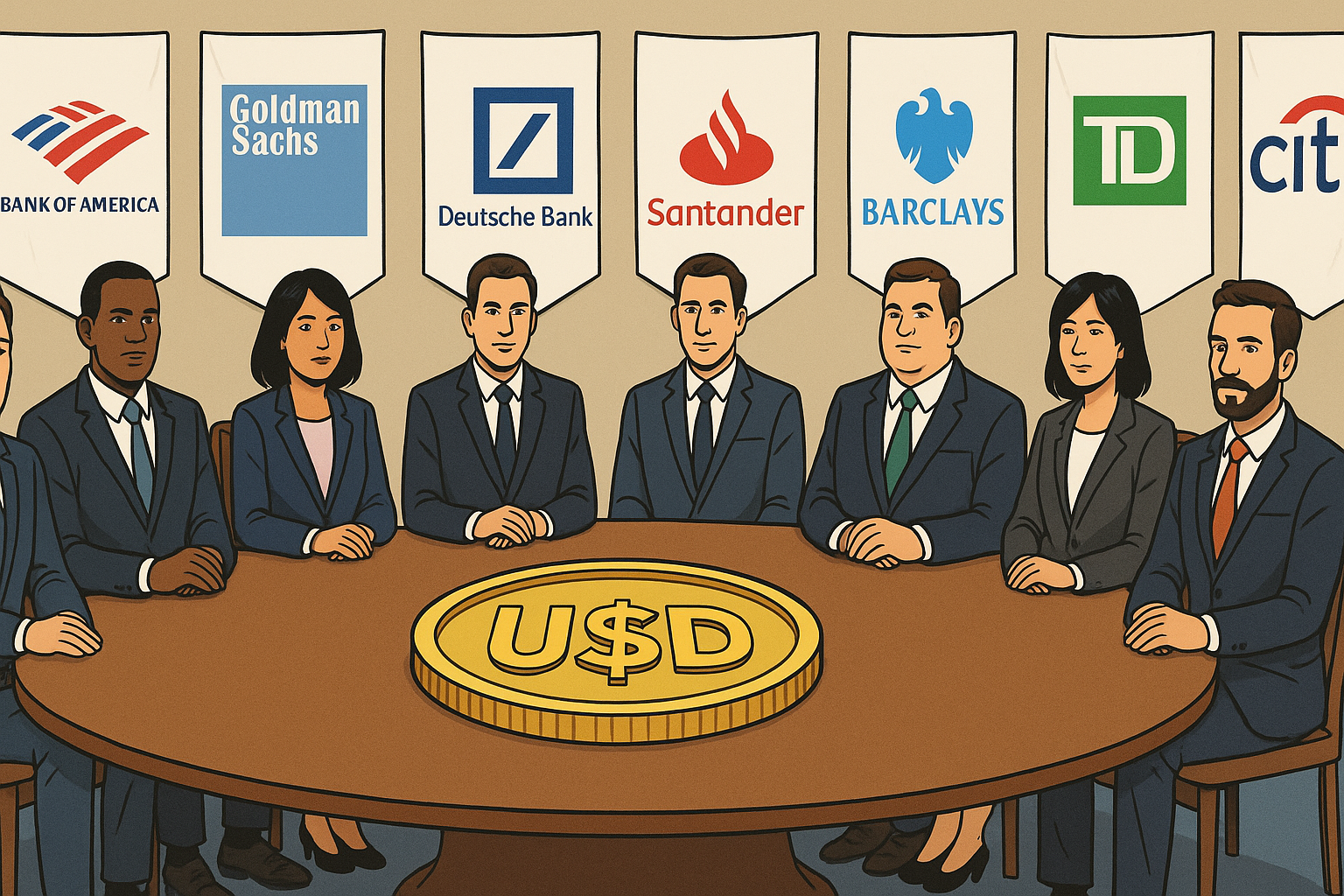Blockchain & DeFi
Bankers Unite: Ten Global Giants Explore a Shared Stablecoin Future

- Share
- Tweet /data/web/virtuals/383272/virtual/www/domains/theunhashed.com/wp-content/plugins/mvp-social-buttons/mvp-social-buttons.php on line 63
https://theunhashed.com/wp-content/uploads/2025/10/banks_stablecoins-1000x600.png&description=Bankers Unite: Ten Global Giants Explore a Shared Stablecoin Future', 'pinterestShare', 'width=750,height=350'); return false;" title="Pin This Post">
A Surprise Move from Traditional Finance
It started with a spark on crypto Twitter—ten of the world’s most influential banks reportedly teaming up to explore a unified stablecoin initiative. The claim was met with both excitement and skepticism, but the core of the rumor turned out to be true. Reuters confirmed that major global banks including Bank of America, Goldman Sachs, Deutsche Bank, BNP Paribas, Santander, Barclays, TD Bank, MUFG, UBS, and Citi are engaged in early discussions about launching a new kind of digital asset initiative—one that could reshape the entire financial landscape.
Their goal? To explore issuing stablecoins pegged to G7 currencies, creating a shared infrastructure that would not only modernize their own settlement systems but also challenge the current dominance of crypto-native stablecoins. Though still in the early stages, this proposed collaboration marks a pivotal moment where traditional finance isn’t just reacting to blockchain innovation—it’s looking to take the lead.
Why Stablecoins—and Why Now?
Stablecoins have become the backbone of the crypto economy. Pegged to fiat currencies like the U.S. dollar or euro, these digital assets offer stability, fast settlement, and global accessibility. Over the past few years, private stablecoins such as USDC and USDT have grown exponentially, moving hundreds of billions of dollars across decentralized finance (DeFi), crypto exchanges, and payment platforms.
For traditional banks, the rise of stablecoins is both an opportunity and a threat. On one hand, the technology offers a faster, cheaper alternative to conventional banking rails. On the other, if left unaddressed, it risks eroding the banks’ control over global payments, liquidity, and customer engagement.
A joint stablecoin initiative allows banks to strike a balance between modernization and control. By building their own stablecoin framework, banks can offer the speed and efficiency of blockchain-based transactions while maintaining the oversight and trust of regulated financial institutions. It’s a move to reclaim relevance in a landscape where decentralization is increasingly becoming the norm.
The Appeal of a Unified Approach
The concept of a shared, interoperable stablecoin is ambitious. Rather than each bank issuing its own digital token—risking fragmentation and technical incompatibility—this model envisions a collaborative framework. Such an approach could enable seamless transfers between banks, create uniform settlement standards, and lower costs for cross-border transactions.
This effort could also serve as a blueprint for future financial infrastructure. Much like the SWIFT network standardized interbank messaging in the 1970s, a stablecoin consortium could define how digital money moves in the 21st century. The benefits go beyond cost savings. Programmable payments, smart contracts for settlement, and tokenized assets could all be layered atop the stablecoin infrastructure.
Moreover, with regulatory pressure mounting on existing stablecoin issuers, a bank-led consortium could offer a more compliant, institutionally trusted alternative. This initiative aligns well with pending legislation such as the GENIUS Act in the U.S. and MiCA in the EU, which aim to create legal clarity and enforce transparency in stablecoin markets.
Roadblocks Ahead: Regulation, Governance, and Trust
However, this initiative will not be easy to pull off. First and foremost, regulatory scrutiny will be intense. Even though these banks already operate under strict financial oversight, issuing a digital currency brings new compliance burdens. How reserves are managed, how consumer protections are enforced, and how cross-border legal differences are reconciled will all be critical challenges.
Another complexity lies in governance. Getting ten major banks—with different geographies, regulations, and strategic priorities—to agree on technical standards, decision-making processes, and liability frameworks is no small feat. Even within a single country, consortium projects often struggle with coordination. On a global scale, the task becomes exponentially harder.
Then there’s the question of trust. Will users—whether corporate clients or end consumers—trust a bank-issued stablecoin more than existing alternatives? Tether and Circle have built significant market share, not just through technology but through established liquidity and wide adoption. Convincing developers, businesses, and fintechs to adopt a new standard will require not just a better product, but a compelling value proposition.
A Broader Trend: Institutions Enter the Blockchain Arena
This initiative doesn’t come in a vacuum. It follows a year of growing institutional interest in blockchain infrastructure. JPMorgan’s JPM Coin has quietly processed billions in internal transfers. In Europe, a separate group of banks is building a euro-denominated stablecoin to comply with MiCA. Meanwhile, the Canton Network and other tokenization platforms are creating private blockchain environments for financial institutions to transact securely.
The difference now is scale and momentum. Never before have ten of the world’s largest banks signaled such collective interest in a unified stablecoin vision. If successful, this initiative could mark the beginning of a new phase in the evolution of money—where digital assets no longer operate on the fringes, but at the very core of global finance.
A Financial Revolution—Or a Digital Rebrand?
Skeptics argue that this may amount to little more than a modernization of traditional banking under a new name. After all, digital money has existed for decades in the form of bank balances and electronic transfers. Does wrapping those balances in blockchain code truly change anything?
Proponents believe it does. The programmability, transparency, and global reach of stablecoins could unlock innovations far beyond what current banking systems allow. Whether used for supply chain finance, real-time payroll, or tokenized securities, a shared stablecoin infrastructure could provide the digital plumbing for a new kind of financial internet.
What’s clear is that banks are no longer content to observe from the sidelines. They are entering the game, cautiously but deliberately. If the consortium succeeds, the lines between traditional finance and crypto may blur in ways we’ve never seen before.
In the end, the question isn’t whether banks will use stablecoins—it’s whether their version will be the one the world adopts.
Blockchain & DeFi
Exodus Goes Full Stack: Wallet Giant Acquires W3C to Dominate Crypto Payments

In a major leap toward integrating self-custody wallets with everyday finance, Exodus Movement has signed a $175 million deal to acquire W3C Corp, the parent company of crypto-friendly payment providers Baanx and Monavate. The acquisition puts Exodus squarely on the path to becoming a vertically integrated player in the crypto payments ecosystem—controlling everything from asset storage to transaction rails.
Wallet meets payments infrastructure
Exodus has built its brand on providing sleek, user-friendly wallets that give users full custody of their digital assets. But this move signals a new ambition: to turn those wallets into true financial hubs, enabling users not only to hold crypto but to spend it with the same ease as fiat currency.
With Baanx and Monavate now under its umbrella, Exodus gains direct access to critical infrastructure like card issuing, transaction processing, and compliance frameworks. That means Exodus users could soon swipe a debit card backed directly by their on-chain assets, or access stablecoin payments seamlessly integrated into the app.
This isn’t about being another crypto wallet. It’s about being the first wallet that also functions like a bank.
Terms of the deal and financing
The acquisition, expected to close in early 2026, is financed through a mix of cash and credit. Exodus is securing funding via a lending facility with Galaxy Digital, backed in part by its Bitcoin holdings. This is both a savvy move and a calculated risk—using crypto collateral in a volatile market can amplify upside, but also exposes the company to market drawdowns.
Still, the message is clear: Exodus is betting on Bitcoin long term, and is leveraging its own balance sheet to double down on crypto-native financial infrastructure.
Strategic shift: from holding to spending
What makes this deal so significant is the directional shift it signals. Most wallets—hardware or software—have stopped short of solving the everyday usability problem. People can hold assets, but spending them usually requires off-ramping through exchanges, third-party cards, or custodians.
By contrast, Exodus now controls a vertically integrated stack that could take a user from cold storage to tap-to-pay in seconds. If executed well, it could mark a major evolution in self-custody—from a niche security practice to a full-featured alternative to traditional banking.
It also opens the door to stablecoin integration, programmable payments, and more advanced DeFi access—all without compromising user control of private keys.
Risk profile: market exposure and compliance
Of course, there are headwinds. The integration of payments infrastructure is complex, especially in jurisdictions where financial compliance is stringent and ever-changing. Onboarding new users, securing licenses, maintaining AML/KYC standards, and building regulatory trust takes time and resources.
There’s also the financing risk. Tying operational runway to crypto market cycles—via Bitcoin-backed credit lines—creates a dependency that can be both a strength and a vulnerability. A bull market could supercharge the project. A correction could tighten liquidity.
But Exodus seems prepared to manage these variables, signaling confidence not just in crypto’s long-term growth, but in its own ability to lead the transition from speculative assets to everyday utility.
What it means for the industry
This acquisition is more than just M&A. It’s an evolution in crypto’s UX. If Exodus can successfully build a wallet that handles custody, compliance, payments, and user experience under one roof, it may set the standard for a new category of fintech.
It could also pressure traditional banks and fintechs to integrate crypto more deeply, or risk being leapfrogged by crypto-native services that offer better speed, lower fees, and superior global access.
Final thoughts
Exodus isn’t just adding features—it’s laying down rails for a self-sovereign financial system. The acquisition of W3C may look like a backend infrastructure play, but it’s really a front-end transformation of how people use money. Wallets are no longer just vaults. They’re becoming launchpads.
Blockchain & DeFi
When DeFi Becomes Finance: How Token Buybacks Are Reshaping Governance at Uniswap, Lido and Aave

The decentralized‑finance sector is increasingly borrowing cues from Wall Street: protocols such as Uniswap, Lido and Aave are deploying token‑buyback strategies that mirror corporate stock repurchases. That shift may come at the cost of decentralization.
From incentives to buybacks
In the early DeFi era, growth was fuelled by liquidity mining, yield farming and community token distribution. But a notable pivot is underway: Uniswap’s “UNIfication” governance proposal seeks to activate previously dormant protocol fees, route them into a treasury engine and use the proceeds to buy back and burn its native token UNI. That move shifts UNI’s role from purely governance to something closer to economic equity. Similarly, Lido has introduced a mechanism tying buybacks of its LDO token to thresholds such as Ethereum’s price and annual revenue. These initiatives signal a broader shift in DeFi from incentive‑driven issuance to revenue alignment and token scarcity.
Centralization under the hood
While buybacks may enhance token value, they also raise governance implications. When a protocol channels revenue into buybacks, decision‑making tends to centralize: fewer tokens outstanding mean fewer holders exerting power, and governance debates can shrink in scope. Uniswap’s UNIfication proposal notably transfers operational control from the community foundation to a core entity, raising questions about how decentralized the system truly remains. That change has ignited pushback from analysts who argue that concentration of power threatens the original ethos of decentralization.
Institutional logic meets decentralised platforms
These buyback programs bring traditional‑finance metrics into DeFi: concepts like yield thresholds, fee capture and token‐supply control are now front and centre. Protocols are acting less like open‑source networks and more like growth companies with value propositions. As one observer noted, the sector is moving from “free experimentation” and “cultural hype” toward “balance‑sheet clarity” and “corporate discipline.” But this evolution also ushers in tension: the community’s demand for openness and collective governance may clash with a finance‑style focus on token value and scarcity.
Risks in disguise
The financial logic is easy to follow, but the governance logic is more complex. Buybacks may temporarily boost token value, but they don’t guarantee sustainable business performance—especially in cyclic markets. Analysts caution that many of these programs rely on treasury reserves rather than recurring revenue streams, which may leave protocols vulnerable in a downturn. More fundamentally, allocating large sums to buybacks can deprioritise innovation, open‑source development and liquidity growth in favour of financial engineering. Lastly, regulators may begin to interpret large token buybacks as dividend‑like distributions, posing legal and compliance risks for protocols that skirt traditional securities frameworks.
What to watch
Going forward, key signals to monitor include how each protocol implements buyback mechanics: whether buybacks are triggered automatically based on transparent rules, or managed ad‑hoc by governing entities. The behaviour of token governance (voter turnout, proposal volume) will also offer insight into centralisation trends. Finally, how token value holds in a downturn will test whether these buyback models represent sustainable economic design or just gimmicks layered on top of crypto’s hype cycle.
Conclusion
The wave of token buybacks by major DeFi protocols marks a turning point. On one hand, it signifies maturation: revenue‑driven models, token‑economies aligned to business outcomes and more familiar investment frameworks. On the other hand, the shift raises core questions about decentralization, governance and the role of community in shaping protocol outcomes. As DeFi continues its evolution, the trade‑off between efficient capital models and autonomy will define the next chapter.
Blockchain & DeFi
Japan’s Banks and Regulator Move Boldly on Yen‑Stablecoin Launch

In a striking push for financial innovation, Japan’s regulatory authority has thrown its weight behind a collaborative initiative by the nation’s largest banks to launch a yen‑backed stablecoin. As Japan positions itself at the frontier of payments and digital finance, this marks a critical turning point in how traditional institutions and blockchain converge.
A new era of payments: regulator says yes
The Financial Services Agency (FSA) of Japan has officially endorsed what it calls its “Payment Innovation Project” — a scheme that brings together major banks and corporate players to issue a yen‑denominated stablecoin. According to the announcement, the project begins this month, and the immediate goal is to pilot payment‑stablecoin use among corporate clients.
Participants include Mizuho Bank, MUFG Bank (via its issuance platform “Progmat”), Sumitomo Mitsui Banking Corporation, and Mitsubishi Corporation alongside its financial arm.
The FSA emphasizes that the move responds to a broader trend: the use of blockchain technology to enhance payment systems and corporate settlement frameworks. It also indicated that after the pilot phase, results and conclusions will be published — meaning the regulator wants transparency and oversight from the start.
Why this matters
This development is significant in several key ways.
Firstly, it signals institutional acceptance of stablecoins within a regulated banking environment — not just in cryptocurrencies or niche use‑cases. By backing a yen‑stablecoin initiative, Japan is saying stablecoins deserve a seat at the table of mainstream finance.
Secondly, the collaboration among major banks matters because they serve hundreds of thousands of corporate clients in Japan. The participating banks and firms collectively serve more than 300,000 corporate users. That means this isn’t a small pilot of a handful of users; it has potential scale and could meaningfully impact corporate treasury, cross‑border settlement, and payment efficiency.
Thirdly, for the broader stablecoin and digital‑asset ecosystem, this is a signal that regulatory acceptance paired with traditional banking infrastructure may accelerate adoption. If banks issue — or co‑issue — stablecoins under the oversight of a regulator like the FSA, then the “wild‑west” narrative of crypto may shift toward “bank‑backed digital money” narratives.
Strategic implications for banks and corporates
For the banks involved, launching a stablecoin gives them a dual opportunity: one, to modernize their internal and cross‑corporate settlement operations, and two, to position themselves as platform providers for digital‑asset infrastructure rather than mere intermediaries. For corporates, the promise is lower settlement friction, more real‑time settlement (or closer), and potential cost savings.
However, this is not without challenges. The banks will need to ensure seats at the table for compliance, reporting, reserve transparency (for the coin‑backing), user protection, operational risk (smart‑contract bugs, blockchain outages, etc.), and possibly new regulatory frameworks. The FSA explicitly stressed the need to ensure users are protected and informed.
What the pilot will test and next steps
The pilot phase begins with issuance of payment‑stablecoins by the banks in question. They will likely test transactions among corporate clients, gauge settlement speed, examine cost savings, user experience, and perhaps integration with broader payment rails. Key metrics will probably include transaction volume, error/risk events, compliance overhead, effects on liquidity/reserve management, and customer uptake.
Following completion, the Japanese regulator intends to publish results and conclusions. That transparency will matter widely, as other jurisdictions and digital‑asset players will watch for lessons learned.
Broader regulatory and industry context
This initiative comes amid a broader wave of regulatory openness and crypto‑fintech experiments in Japan. The FSA and other Japanese regulators have recently been active in reviewing regulation for crypto, including considering whether banks can hold crypto, and addressing issues like insider trading in crypto markets.
Japan’s influential role here may serve as a model for other banking systems where stablecoins are considered more than speculative tokens and instead digital representations of fiat‑value for everyday payment and settlement.
Risks and considerations
Even with regulatory backing and major bank involvement, several caveats remain. It’s still early days, so operational glitches could occur — blockchain failures, integration issues with legacy systems, or unanticipated regulatory burdens. The banks will also need to navigate reserves and backing transparency: if the stablecoin is truly backed 1:1 by yen or equivalent assets, reserve audits will be important. They must also address AML/KYC and cross‑border legal issues if the stablecoin is used internationally.
Another consideration is whether corporates will adopt in meaningful volume — changing behavior from existing payment methods (bank transfers, commercial paper, etc.) takes time. And finally, competition could come from non‑bank stablecoins or global stablecoin initiatives, meaning banks must differentiate on trust, integration and regulation.
What to watch
In the coming weeks and months, it will be important to watch for when the banks issue the stablecoin, how many corporates sign up, what volume is processed, how settlement times compare to legacy methods, and whether the project expands beyond domestic corporate clients into cross‑border flows or retail use. Also of interest: how the FSA evaluation is structured and what transparency requirements are imposed.
For the crypto industry more broadly, this could signal an acceleration of tokenized fiat led by regulated banks — possibly raising the bar for stablecoin projects and redefining competition from un‑backed or lightly‑backed tokens toward bank‑backed or regulated stablecoins.
-

 Cardano2 months ago
Cardano2 months agoCardano Breaks Ground in India: Trivolve Tech Launches Blockchain Forensic System on Mainnet
-

 Cardano2 months ago
Cardano2 months agoCardano Reboots: What the Foundation’s New Roadmap Means for the Blockchain Race
-

 Cardano2 days ago
Cardano2 days agoSolana co‑founder publicly backs Cardano — signaling rare cross‑chain respect after 2025 chain‑split recovery
-

 Bitcoin2 months ago
Bitcoin2 months agoQuantum Timebomb: Is Bitcoin’s Foundation About to Crack?
-

 Cardano2 months ago
Cardano2 months agoAfter the Smoke Clears: Cardano, Vouchers, and the Vindication of Charles Hoskinson
-

 Cardano2 months ago
Cardano2 months agoMidnight and Google Cloud Join Forces to Power Privacy‑First Blockchain Infrastructure
-

 Ripple2 months ago
Ripple2 months agoRipple CTO David “JoelKatz” Schwartz to Step Down by Year’s End, but Will Remain on Board
-

 News2 months ago
News2 months agoRipple’s DeFi Awakening: How mXRP Is Redefining the Role of XRP









